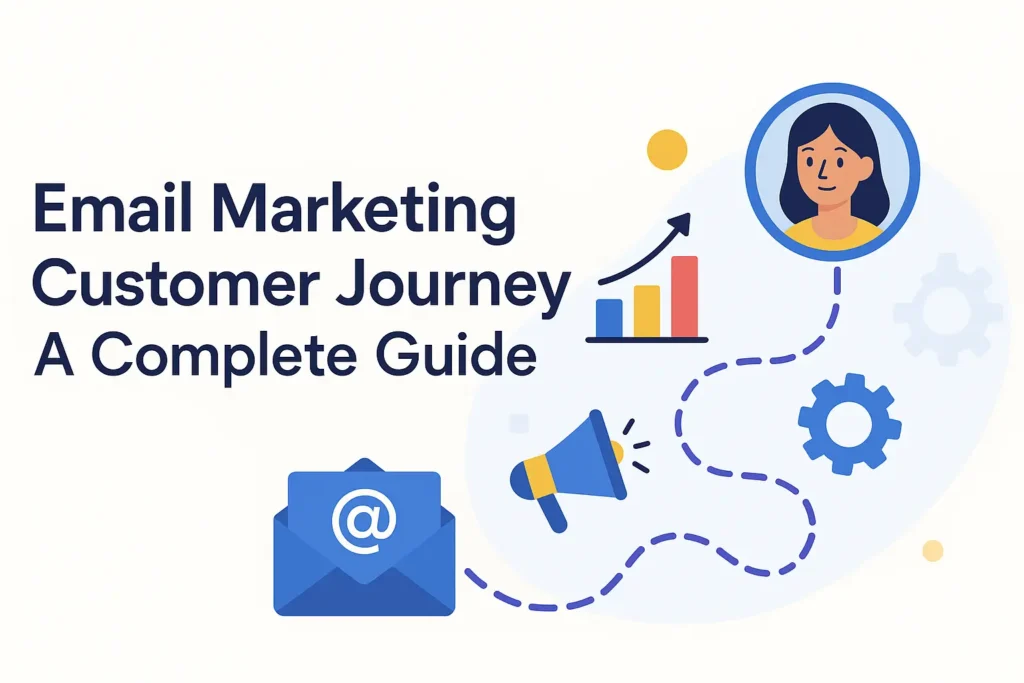In the age of the digital transition, it is not just advantageous, but crucial to comprehend the email marketing customer journey. That is the difference between sending out emails to people casually and then most times without an aim while on the other hand developing and nurturing the prospects into loyal customers by gaining their trust as well as that of their network.
It provides you with all the basics relevant to your business, as well as exemplified and action-oriented ideas, tips, and strategies from the experts to help you create an unbeatable email marketing campaign.

Table of Contents
What is the Email Marketing Customer Journey?
Suppose the first time you are in a small café where people come to drink coffee. You like the atmosphere, you drink the coffee, and the next thing you come back you are considered a repeat offender. That organic process aligns well with the email marketing customer journey map: the sequence of interactions a person goes through from the moment they receive the first message about your business to the point when they actively promote your services.
In technical terms, the email marketing customer journey simply means the process of handling the interactions of a subscriber with your company through email depending on the stage that they are in the buying cycle. Each email nudges them closer to a decision, relationship, or renewed loyalty.
Consequently, 79% of customers expect brands to understand their expectations, as stated by Salesforce. That is why mapping and personalizing it is so important here.
Why the Email Marketing Customer Journey Matters
It is not reasonable to expect sex on the first date, do you?
Likewise, it is difficult to start with a hard-sell approach when a person has recently come across your brand.
The major advantages that can be derived from mapping the customer journey in the context of email marketing are as follows:
- Timeliness of the message delivery
- Build trust and credibility
- Increase customer satisfaction rates and, consequently, the rate of customer loyalty and the rate of customer churn
- Increase conversion rates dramatically
Specifically, Litmus claimed that email marketing has an average return on investment of $42 for every dollar spent, but only when done correctly.
Email Automation: Powering the Customer Journey
Email automation is the engine that drives the effective implementation of an email marketing customer experience.
Unlike the traditional way of sending emails, ActiveCampaign and Mailchimp send emails based on the users’ activity.
Some examples include:
- Response messages when the user signs up for an account
- Abandoned cart reminders
- Birthday offers
- Post-purchase follow-ups
The kind of emailing can be controlled to feel smart and humanized without seeming intrusive.
Lead Nurturing: Transitioning Prospects from One Stage to Another
Lead nurturing is the process of converting the mere browser into a ready buyer.
When a subscriber becomes a member of your list, they are likely interested but skeptical. Lead nurturing through value-packed emails helps:
- Build rapport
- Answer their questions
- Ease their fears
Here is a possible great lead nurturing sequence:
- Educational emails (e.g., blog posts, webinars)
- Testimonials and case studies
- Promotions after establishing some level of trust
According to HubSpot, nurtured leads generate 47% larger purchases than non-nurtured leads.
Email Segmentation: Tailoring Messages for Impact
It’s like going to a beach party dressed formally — awkward!
Email segmentation involves categorizing your list based on characteristics like:
- Interests
- Behavior
- Location
- Purchase history
Smart segmentation allows you to send meaningful and relevant content, increasing open and click-through rates.
Personalized Email Marketing: Creating New Experiences
Welcome to the world of personalized email marketing!
Personalization is not just about using a subscriber’s first name — it’s about tailoring:
- Subject lines
- Product recommendations
- Dynamic content blocks
- Timing based on user behavior
Executed well, emails feel like advice from a friend rather than a sales pitch.
Statista notes that personalized newsletters have transaction rates six times higher than non-targeted ones.
Understanding the Email Lifecycle
Managing the email lifecycle means guiding customers at every stage:
- Acquisition: Building awareness
- Consideration: Educating and earning trust
- Purchase: Sealing the deal
- Retention: Keeping them happy
- Re-engagement: Winning back attention
Each stage demands a customized email marketing strategy, boosting customer satisfaction and lifetime value.
Conversion Optimization: Turning Interest into Action
Ultimately, your email marketing customer journey should drive action.
Conversion optimization involves refining:
- Your subject lines
- Email copy
- Call-to-action (CTA)
- Landing pages
Effective strategies include:
- A/B testing
- Using urgency (“limited-time offers”)
- Reducing friction to make CTA easier
Learn more through Optimizely’s beginner guide.
Re-Engagement Campaigns: How to Secure Lost Customers
If subscribers ghost you, don’t panic.
Re-engagement campaigns can win them back by using:
- “We miss you!” messages with discounts
- Surveys to understand disengagement
- Fresh content or new product launches
Campaign Monitor reveals that 45% of recipients who receive re-engagement emails open future ones — a valuable chance to reestablish connection.
Conclusion: Recapping the Steps of Successful Email Marketing
Creating a smart email marketing customer journey means guiding your customer hand-in-hand across all stages with:
- Respect
- Relevance
- Honesty
Remember:
- Automate smartly and on time
- Nurture leads with valuable information
- Segment for sharper targeting
- Personalize deeply to foster emotional bonds
- Optimize conversions and re-engage strategically
When you prioritize customer value, sales and loyalty naturally follow.
